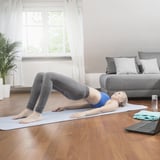

After studying, reviewing, and saving countless Instagram workouts, I had a revelation about my own at-home fitness routine: I never, ever wear sneakers when working out in my living room.
Was I making a massive fitness mistake? Was I setting myself up for a potential injury?
I noticed many of the instructors live streaming classes were wearing sneakers, while snapshots of people following along with the classes revealed they were fully outfitted, too.
According to Trevor Thieme, CSCS, and content director at Openfit, whether or not you should work out at home without sneakers depends on what activity you're performing and how much experience you have in shoeless workouts.
First, the obvious examples - yoga, Pilates, and possibly barre. These workouts are typically performed without shoes and socks, though grippy socks are commonly used in studios.
With these exercises, Thieme says you should "almost always ditch your shoes to optimize the sensory feedback you get from your feet."
You are also usually working on a mat, which will help enhance your grip and help protect your knees, elbows, and tailbone, Thieme says.
I was most curious about strength training workouts, as I also tend to ditch my sneakers for those at-home routines, too.
Here's where the answer gets a little more complicated.
"If you're new to shoeless training, start slowly - performing only part of each workout in bare feet, or with socks on, to allow your feet and body to adjust," Thieme explains.
"It will feel awkward at first because the muscles in your feet have likely become weakened from wearing shoes all day. Shoes are necessary for protection and comfort while moving about in today's world, but they also do a lot of the stabilizing work that would otherwise be done by the muscles in your feet," he adds.
And stronger feet, he explains, could help reduce the risk of foot and ankle injuries, as well as boost lifting performance by providing a stable foundation.
"If you lift barefoot, the sensory feedback you'll get from having your feet in direct contact with the floor can enhance your 'proprioception,' or your awareness of your body in space. That can translate into better balance, coordination, stability, and movement mechanics," Thieme notes.
So, if you're interested in ditching your shoes while you're lifting weights at home, be sure to work this change into your routine very slowly. Again, Thieme suggests going shoeless for only one to two exercises per workout at first.
When it comes to completing cardio or HIIT workouts without sneakers, you have to look at a few factors - namely safety.
When your workout is packed with plyometrics or jumping moves, Thieme recommends keeping shoes on to minimize the impact.
For all exercises, you'll want to look at the surface on which you're performing the moves, as it might not be a safe fit for shoeless training. For example, if you sweat a lot in cardio workouts, wearing sneakers could help you avoid injuries.
Apart from figuring out your shoe preferences, before starting an at-home workout program, assess your environment and make the necessary adjustments so you can exercise safely. Thieme suggests giving yourself at least six square feet of space, clearing the floor of objects you could trip over or that pose danger, and paying attention to the temperature of the room.
Click here for more health and wellness stories, tips, and news.




0 comments :
Post a Comment